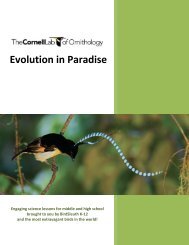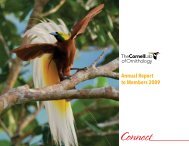National Survey of Fishing, Hunting, and Wildlife ... - All About Birds
National Survey of Fishing, Hunting, and Wildlife ... - All About Birds
National Survey of Fishing, Hunting, and Wildlife ... - All About Birds
You also want an ePaper? Increase the reach of your titles
YUMPU automatically turns print PDFs into web optimized ePapers that Google loves.
<strong>Fishing</strong>—The sport <strong>of</strong> catching orattempting to catch fish with a hook<strong>and</strong> line, bow <strong>and</strong> arrow, or spear; italso includes catching or gatheringshellfish (clams, crabs, etc.); <strong>and</strong> thenoncommercial seining or netting<strong>of</strong> fish, unless the fish are for use asbait. For example, seining for smelt isfishing, but seining for bait minnows isnot included as fishing.<strong>Fishing</strong> equipment—Items ownedprimarily for fishing:Rods, reels, poles, <strong>and</strong> rodmakingcomponentsLines <strong>and</strong> leadersArtificial lures, flies, baits, <strong>and</strong>dressing for flies or linesHooks, sinkers, swivels, <strong>and</strong> otheritems attached to a line, except lures<strong>and</strong> baitsTackle boxesCreels, stringers, fish bags, l<strong>and</strong>ingnets, <strong>and</strong> gaff hooksMinnow traps, seines, <strong>and</strong> baitcontainersDepth finders, fish finders, <strong>and</strong> otherelectronic fishing devicesIce fishing equipmentOther fishing equipmentFreshwater—Reservoirs, lakes, ponds,<strong>and</strong> the nontidal portions <strong>of</strong> rivers <strong>and</strong>streams.Great Lakes fishing—<strong>Fishing</strong> in LakesSuperior, Michigan, Huron, St. Clair,Erie, <strong>and</strong> Ontario, their connectingwaters such as the St. Mary’s Riversystem, Detroit River, St. Clair River,<strong>and</strong> the Niagara River, <strong>and</strong> the St.Lawrence River south <strong>of</strong> the bridgeat Cornwall, New York. Great Lakesfishing includes fishing in tributaries <strong>of</strong>the Great Lakes for smelt, steelhead,<strong>and</strong> salmon.Home—The starting point <strong>of</strong> a wildlife-relatedrecreational trip. It may be apermanent residence or a temporary orseasonal residence such as a cabin.<strong>Hunting</strong>—The sport <strong>of</strong> shooting orattempting to shoot wildlife with firearmsor archery equipment.Rifles, shotguns, muzzleloaders, <strong>and</strong>h<strong>and</strong>gunsArchery equipmentTelescopic sightsDecoys <strong>and</strong> game callsAmmunitionH<strong>and</strong> loading equipment<strong>Hunting</strong> dogs <strong>and</strong> associated costsOther hunting equipmentL<strong>and</strong> leasing <strong>and</strong> owning—Leasingor owning l<strong>and</strong> either singly or incooperation with others for the primarypurpose <strong>of</strong> fishing, hunting, or wildlifewatching on it.Maintain natural areas—To set aside1/4 acre or more <strong>of</strong> natural environment,such as wood lots or open fields,for the primary purpose <strong>of</strong> benefitingwildlife.Maintain plantings—To introduceor encourage the growth <strong>of</strong> food <strong>and</strong>cover plants for the primary purpose <strong>of</strong>benefiting wildlife.Metropolitan Statistical Area(MSA)—A Metropolitan StatisticalArea is a grouping <strong>of</strong> one or morecounties or equivalent entities thatcontain at least one urbanized area<strong>of</strong> 50,000 or more inhabitants. The“Outside MSA” classification includecensus-defined Micropolitan StatisticalAreas (or Micro areas). A Micro areais defined as a grouping <strong>of</strong> one or morecounties or equivalent entities thatcontain at least one urban cluster <strong>of</strong> atleast 10,000 but less than 50,000 inhabitants.Refer to , for a moredetailed definition <strong>of</strong> the MetropolitanStatistical Area.Migratory birds—<strong>Birds</strong> that regularlymigrate from one region or climate toanother such as ducks, geese, <strong>and</strong> doves<strong>and</strong> other birds that may be hunted.Multiple responses—The term usedto reflect the fact that individuals ortheir characteristics fall into more thanone reporting category. An example<strong>of</strong> a big game hunter who hunted fordeer <strong>and</strong> elk demonstrates the effect <strong>of</strong>multiple responses. In this case, addingthe number <strong>of</strong> deer hunters (one) <strong>and</strong>elk hunters (one) would overstate thenumber <strong>of</strong> big game hunters (one)because deer <strong>and</strong> elk hunters are notmutually exclusive categories. Incontrast, for example, total participantsis the sum <strong>of</strong> male <strong>and</strong> female participants,because “male” <strong>and</strong> “female” aremutually exclusive categories.Nonresidents—Individuals who donot live in the State being reported.For example, a person living in Texaswho watches whales in California isa nonresidential wildlife-watcher inCalifornia.Nonresponse—A term used to reflectthe fact that some <strong>Survey</strong> respondentsprovide incomplete sets <strong>of</strong> information.For example, a <strong>Survey</strong> respondentmay have been unable to identify theprimary type <strong>of</strong> hunting for which agun was bought. Total hunting expenditureestimates will include the gunpurchase, but it will not appear asspending for big game or any othertype <strong>of</strong> hunting. Nonresponses result inreported totals that are greater than thesum <strong>of</strong> their parts.Observe—To take special interest inor try to identify birds, fish or otherwildlife.Other animals—Coyotes, crows,foxes, groundhogs, prairie dogs,raccoons, alligators, <strong>and</strong> similaranimals that can be legally hunted <strong>and</strong>are not classified as big game, smallgame, or migratory birds. They maybe classified as unprotected or predatoryanimals by the State in which theyare hunted. Feral pigs are classifiedas “other animals” in all States exceptHawaii, where they are considered biggame.Participants—Individuals who engagein fishing, hunting, or a wildlifewatchingactivity. Unless otherwisestated, a person has to have hunted,fished, or wildlife watched in 2011 tobe considered a participant.Plantings—See “Maintain plantings.”Primary purpose—The principalmotivation for an activity, trip, orexpenditure.Private l<strong>and</strong>—L<strong>and</strong> owned by a business,nongovernmental organization,private individual, or a group <strong>of</strong> individualssuch as an association or club.<strong>Hunting</strong> equipment—Items ownedPublic l<strong>and</strong>—L<strong>and</strong> that is owned byprimarily for hunting:local governments (such as countyparks <strong>and</strong> municipal watersheds),U.S. Fish <strong>and</strong> <strong>Wildlife</strong> Service <strong>and</strong> U.S. Census Bureau 2011 <strong>National</strong> <strong>Survey</strong> <strong>of</strong> <strong>Fishing</strong>, <strong>Hunting</strong>, <strong>and</strong> <strong>Wildlife</strong>-Associated Recreation 97






